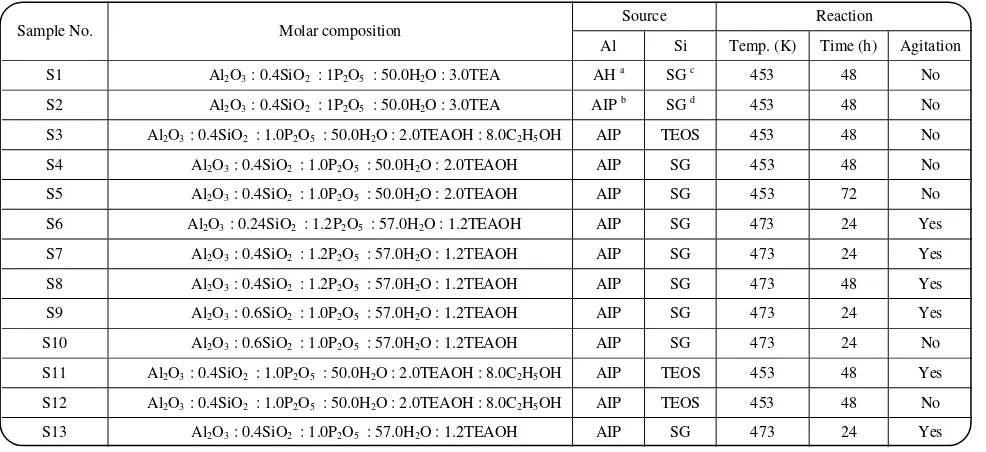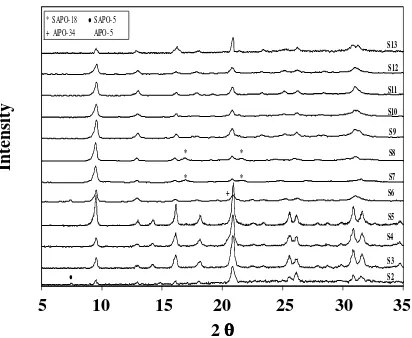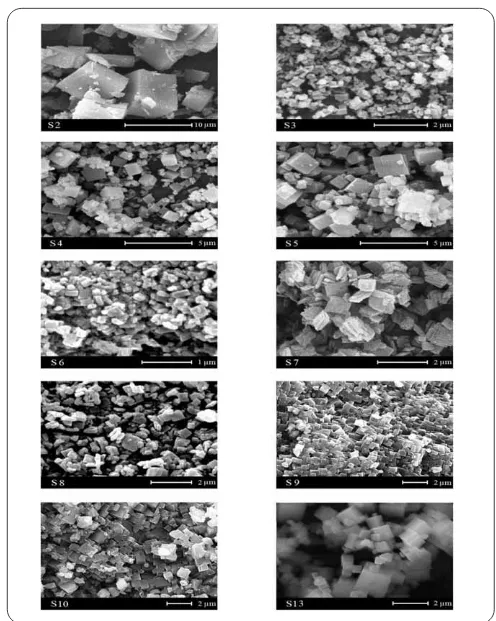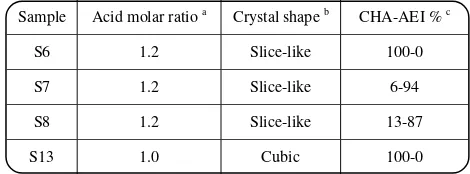Effect of Synthesis Parameters on Phase Purity,
Crystallinity and Particle Size of SAPO-34
Emrani, Peyman; Fatemi, Shohreh*
+••••; Ashraf Talesh, Siamak
School of Chemical Engineering, College of Engineering, University of Tehran, Tehran, I.R. IRAN
ABSTRACT: An account is presented on investigation of the effects of synthesis parameters, i.e., reaction sources, silica to alumina ratio, acid molar ratio and crystallization conditions on the crystallinity, morphology and particle size of SAPO-34. The synthesis conditions were designed to produce small particles with narrow size range. The prepared samples were characterized by XRD and SEM techniques in order to evaluate the crystallinity, morphology and particle size. The XRD pattern was used to evaluate the crystallinity and phase purity. The phase purity of some samples, including SAPO-18 was determined by DIFFaX analysis from XRD data. The results were shown that formation of SAPO-18 is enhanced by increasing the acid content in the primary mixture. lower Si/Al ratio in a primary mixture resulted in production of AlPO’s and SAPO-5 impurities. The type of template, silicon and aluminum source, acid concentration, agitation during crystallization, temperature and time of crystallization were found out as the significant parameters for controlling crystallinity and purity, particle size and morphology of the product.
KEY WORDS:SAPO-34, Crystallinity, Synthesis parameter, Particle size.
INTRODUCTION
Silicoaluminophosphate (SAPO) molecular sieves form a new class of microporous crystalline materials comparable to well known zeolites commonly composed of AlO4, PO4 and SiO4 tetrahedron [1-4]. SAPO-34 is a silicoaluminophosphate with the formula of SixAlyPzO2, where x = 0.01 – 0.98, y = 0.01 – 0.60, z = 0.01 – 0.52, and x + z = y [5].
Small-pore SAPO-34 with chabazite (CHA) structure and pore diameters of approximately 0.38 nm has received great attention in recent years due to its high selectivity to light gases separation [6-7] and methanol to olefin reaction [8-10]. Recent researches have been focused on production of small and pure zeolite and zeolite-like particles with narrow particle size distribution
due to considerable increase in their catalytic and separation performances [11-13].
To control particle size, morphology and crystallinity, it is important to understand the growth mechanism(s). There are number of studies reported on investigation of synthesis parameters of SAPO-34 such as synthesis method [13-14], templating agent [8,10] and heating method [15-16]. Hirota and co-workers [13] examined the synthesis of nanocrystals SAPO-34 by control of crystal growth with use of a dry gel conversion method. Also, size control of SAPO-34 crystals investigated by using various templating agent [10] and the shape and crystal size of SAPO-34 controlled by using various source type and the H2O/Al2O3 molar ratio with
*To whom correspondence should be addressed.
+E-mail: shfatemi@ut.ac.ir
ƔOther address: Oil and Gas center of Excellence, Tehran, I.R. IRAN
Table 1: Composition of reaction mixtures.
Source Reaction
Sample No. Molar composition
Al Si Temp. (K) Time (h) Agitation
S1 Al2O3 : 0.4SiO2 : 1P2O5 : 50.0H2O : 3.0TEA AH a SG c 453 48 No
S2 Al2O3 : 0.4SiO2 : 1P2O5 : 50.0H2O : 3.0TEA AIP b SG d 453 48 No
S3 Al2O3 : 0.4SiO2 : 1.0P2O5 : 50.0H2O : 2.0TEAOH : 8.0C2H5OH AIP TEOS 453 48 No
S4 Al2O3 : 0.4SiO2 : 1.0P2O5 : 50.0H2O : 2.0TEAOH AIP SG 453 48 No
S5 Al2O3 : 0.4SiO2 : 1.0P2O5 : 50.0H2O : 2.0TEAOH AIP SG 453 72 No
S6 Al2O3 : 0.24SiO2 : 1.2P2O5 : 57.0H2O : 1.2TEAOH AIP SG 473 24 Yes
S7 Al2O3 : 0.4SiO2 : 1.2P2O5 : 57.0H2O : 1.2TEAOH AIP SG 473 24 Yes
S8 Al2O3 : 0.4SiO2 : 1.2P2O5 : 57.0H2O : 1.2TEAOH AIP SG 473 48 Yes
S9 Al2O3 : 0.6SiO2 : 1.0P2O5 : 57.0H2O : 1.2TEAOH AIP SG 473 24 Yes
S10 Al2O3 : 0.6SiO2 : 1.0P2O5 : 57.0H2O : 1.2TEAOH AIP SG 473 24 No
S11 Al2O3 : 0.4SiO2 : 1.0P2O5 : 50.0H2O : 2.0TEAOH : 8.0C2H5OH AIP TEOS 453 48 Yes
S12 Al2O3 : 0.4SiO2 : 1.0P2O5 : 50.0H2O : 2.0TEAOH : 8.0C2H5OH AIP TEOS 453 48 No
S13 Al2O3 : 0.4SiO2 : 1.0P2O5 : 57.0H2O : 1.2TEAOH AIP SG 473 24 Yes
a) Aluminium hydroxide, b)Aluminium isopropoxide, c)Silica gel, d)Tetra-ethyl orthosilicate.
microwave heating source [15]. However, a comparative study has been remained for this research to determine the effect of various conditions and sources on the quality of the synthesized product. This work attempts to verify the synthesis of fine and uniform crystalline particles of SAPO-34 and establish a relation between the synthesis parameters and particle size and crystallinity of the prepared material. The comprehensive investigation on the influence of synthesis parameters, including the reagent source and composition of reaction mixture, time and temperature of reaction and agitation during crystallization on crystallinity, purity, morphology and particle size of the resulted phase has been discussed in detail.
EXPERIMENTAL SECTION
Reagents
Aluminium isopropoxide (98 wt.%, Merck) and aluminium hydroxide (Merck), silica gel 60 (Merck) and tetraethyl orthosilicate (TEOS), tetraethyl ammonium hydroxide (35 wt.%, Aldrich), triethanolamine (99 wt.%, Merck) and H3PO4 (85 wt.% aqueous solution, Merck) were selected as the reaction sources. High purity ethanol (99.9 wt.%, Merck) was used as the solvent only if TEOS was chosen as the silica source.
Synthesis method
SAPO-34 samples were prepared in sol-gel media using hydrothermal crystallization process. The reaction
mixture was prepared by mixing phosphoric acid and deionized water with Aluminium source (i.e. Aluminium isopropoxide or aluminium hydroxide) in a 500 mL Pyrex beaker bellow room temperature until a homogenous mixture was obtained. The organic template (i.e. TEA or TEAOH) was then added to the mixture, and the mixing was continued for another 10 to 30 min. Afterward the silica source (i.e. TEOS or silica gel) was added to the mixture, and finally the reaction mixture was aged for 12 h at room temperature.
The hydrothermal process was carried out in Teflon-lined autoclave under autogenous pressure at an adjusted temperature for a fixed period of time. The crystallization reaction was carried out at crystallization temperatures of 453 and 473 K, crystallization times of 24, 48 and 72 h and in presence or absence of agitation. The solid product subsequently was separated from its mother’s liquor by centrifugation and washed with distilled water until the pH was approached to 7; afterward it was calcined in the air atmosphere at 750 K for 5 h to remove organic template molecules at a heating rate of 0.6 K/min. The molar composition of reaction mixture, the sources of synthesis material and the synthesis conditions are presented in Table 1.
Characterization
Table 2: Relative crystallinity and particle size of samples.
Sample
Result S1 S2 S3 S4 S5 S6 S7 S8 S9 S10 S11 S12 S13
R.C.a % NM b 43.4 66.4 67.8 100.0 36.4 41.8 46.9 55.2 43.0 43.1 36.9 53.5
P.S.c(μm) NM 7.8 0.4 1.4 2.7 0.3 0.5 0.7 0.8 1.4 NM NM 1.6
a) Relative crystallinity, b) Not measured, c) Max dimension of particle size evaluated by SEM photographs.
Fig.1: X-ray diffraction pattern of resultant samples.
radiation (Ȝ =1.5418 ºA) operating at 40 kV and 40 mA with a graphite monochromator in the diffracted beam path. The step size and time were selected 2ș of 0.04º and 10 s, respectively. The relative crystallinity of the products was determined based on the X-ray diffraction data of the three most intense peaks at 2ș of 9.5º, 20.6º, and 30.8º. The sample with the highest crystallinity was used as the reference to calculate the relative crystallinity of the samples.
Furthermore, the diffracted intensity algorithm, DIFFaX, was used for calculation of CHA to AEI ratio because of presence of SAPO-18 impurity with AEI structure in some products [17]. Scanning electron microscopy (SEM, Philips XL30 30 kV) was employed to obtain the size and morphology of the crystalline products.
RESULTS AND DISCUSSION
Investigation of the results demonstrated influence of many factors, including the type and/or amount of reagent sources (i.e. silica, alumina and template) and the reaction conditions (i.e. time, temperature and agitation) on the crystallinity, morphology and particle size. Among these factors, the type and amount of reagent sources had
more pronounced effects. Fig. 1 shows the X-ray diffraction pattern of the samples prepared at different experiments. In order to detect the presence of phase impurity, the obtained patterns were compared with reference pattern [18]. The impure phases were detected in some experiments such as SAPO-5 and SAPO-18 coexisting in the final product of SAPO-34. Fig. 2 exhibits the SEM photo of prepared samples. Also, Table 2 include of relative crystallinity and particle size of samples was prepared by using resulted XRD patterns and SEM photographs. The effect of the synthesis parameters has been discussed in detail in the following sections.
Effect of reaction source
The reagent sources affect the physical and chemical behavior of reaction mixture. Variation of the reagent source causes significant changes in the synthesized product. The effect of source materials from most common sources is investigated according to the following.
Aluminium source
Because of the high aluminium content in zeotypes, it is difficult to prepare actual homogenous precursor mixture. In this way using desirable aluminium source would help making uniform reaction mixture and thereby increasing phase purity and crystallinity of product. Among aluminium sources, Aluminium IsoPropoxide (AIP) can dissolve at room temperature, whereas dissolution of Aluminium Hydroxide (AH) in aqueous media requires more severe conditions. Samples S1 and S2 have been prepared in the same condition by AH and AIP, respectively). The non-homogeneous precursor obtained from reagent sources of sample S1 compared with S2 clearly indicated that using organic base of aluminium may lead to a more homogeneous reaction precursor. The SAPO yield of S1 was so inconsiderable that any analyses could not be taken.
S2 S9
S8
S7 S6
S5
S4
S3 S11
S10 S13
S12
* SAPO-18 Ɣ SAPO-5 + AlPO-34 AlPO-5
* *
* *
+
Ɣ
5 10 15 20 25 30 35 2 θθθθ
In
ten
Silica source
Silica source is one of the most influenced synthesis parameters on the particle size and morphology. A systematic study of the type of silica source on particle size of zeolites in the presence of the template agent has been reported elsewhere [19].
Silica gel and TEOS were used as an inorganic and organic source of silica, respectively, to study the influence of silica source on the size and crystallinity of the SAPO-34 product. During preparation of synthesis solution, silica gel was introduced directly to the aqueous reaction mixture without addition of any organic solvent (sample S4); whereas ethanol was employed as the solvent of TEOS (sample S3). As seen in the present study, silica gel exhibited lower reactivity compared to TEOS; whereas the higher reactivity of TEOS was achieved due to the faster hydrolysis resulted in the higher rate of nucleation and crystallization [20]. As shown in Table 2, because of Si incorporation in the framework, the difference of relative crystallinity of S3 and S4 is not significant, although the XRD pattern of S3 was found to have significance broader smaller crystallite size rather than S4. The particle of cubic shape with the relatively narrow range of 0.1 to 0.4 microns were observed for sample S3 in SEM image of Fig. 2, while the particle size of S4 was evaluated around 0.1 to 1.4 microns.
Structure-directing agent
The elemental composition, local microscopic structure and morphology of a specific zeotype may change using different types of templates. Furthermore, one template may produce zeotypes with different structures by varying the synthetic conditions and one type of molecular sieve could also be synthesized in the presence of different organic templates [21-22]. Two templates of TEA and TEAOH were used comparatively, as an organic structure directing agent in this study. The results revealed that using different templates, TEA and TEAOH, produced different particle size, crystallinity and purity. Clearly, addition of TEA resulted in the reduction of the number of nuclei formed in the high amount of aluminate in synthesis solution, according to the fact that TEA forms complexes with free aluminate anions in the solution [19]. It is noted that the TEA can be used as a template for either SAPO-5 or SAPO-34, and less SiO2 in the gel favors to SAPO-5
Table 3: The effect of acid molar ratio on morphology and phase purity of samples.
Sample Acid molar ratio a Crystal shape b CHA-AEI % c
S6 1.2 Slice-like 100-0
S7 1.2 Slice-like 6-94
S8 1.2 Slice-like 13-87
S13 1.0 Cubic 100-0
a) Acid molar composition ratio in reaction stoicheometry , b) Evaluated by SEM photos, c) Calculated by DIFFaX that spots binary structures; the other by-product may exist too.
formation [5]. SEM photos of S2 and S4 in Fig.2 has shown that TEAOH can produce SAPO-34 with higher purity and smaller particle size less than 1.4 μm, while using TEA caused to the presence of impurity and oversize particles. Moreover, XRD analysis of S2 indicating low relative crystallinity and presence of SAPO-5 as undesirable crystallite phase, confirms the obtained results from SEM photos. The absence of a baseline drift and high peak intensity with no line broadening of S4 indicated high crystallinity when using TEAOH as the template. As shown in Table 2, the relative crystallinity of the sample S2 was calculated to be 64.0% of the sample S4.
Effect of acid ratio
Table 3 indicates the sensitivity of crystallization to the amount of acid in reaction precursor and suggests the possibility of synthesized SAPO with different morphologies by varying the amount of acid, which allows forming AEI impurity in final product. By enhancement of the acid molar ratio in the precursor mixture from 1.0 (sample S13) to 1.2 (sample S7), formation of SAPO-18 with smaller dimensions was dominated in crystalline product and indicated more impurities whenever the higher acid concentration is used in primary reaction mixture. In addition observing 21.9% reduction of relative crystallinity of S7 compared to S13 can be explained by different crystallization condition of AEI compared to CHA.
Effect of Si/Al ratio
to the formation of some crystalline phases of AlPO’s because the low silicon amount may cause incomplete incorporation of silicon in aluminophosphate structure units. Presence of AlPO-5 and AlPO-34 crystalline phase with AFI and CHA structures, respectively, was confirmed by comparison of XRD pattern of sample S6 with references [26-27]. According to Table 2, by increasing Si/Al ratio from 0.24 (sample S6) to 0.4 (sample S7), the enhancement of particle size and 14.8% improvement of relative crystallinity were observed.
Effect of reaction condition
It was found that the crystallinity and size of SAPO-34 affected dramatically by the temperature, time and mixing condition of crystallization reaction. The interactive effect of the time and temperature of reaction on the crystallinity and size of product could be deduced from using the wide ranges of time and temperature in production of SAPO-34. The less crystallization time may be used to control the particle size of product at the higher reaction temperatures to avoid growing the particle size, whereas at lower temperatures, crystallization time may be prolonged to compensate low crystallization reaction rate. However, to minimize the ultimate particle size by controlling the crystal growth, relatively lower crystallization temperatures should be employed. Lower temperatures favor the nucleation since the activation energy required for crystal growth is usually higher [28]. Nonetheless, the short time hydrothermal treatment of precursor solution and/or low crystallization temperature may results in non-fully crystalline SAPO-34 thereby low product crystallinity.
The effect of crystallization time can be seen comparatively from samples S4 and S7, which were prolonged further 24 h to form S5 and S8, respectively. The intensity and sharpness of the diffraction peaks in XRD patterns of both samples increased as the reaction time was exceeded, which implied more crystallinity and larger particle size of S5 and S8 as could be observed in Table 2. It was observed 47.5% improvement of the relative crystallinity of S4 within formation of S5 by increasing the time of reaction from 48 to 72 h, whereas crystallinity enhancement was 12.2% by time prolongation of S7 (24 h) to produce S8 (48 h). Furthermore, it can be seen from Table 3 that AEI ratio decreased inconsiderably as time enhanced for S7 to form S8.
Furthermore, the agitation during crystallization was found to have positive effects on the crystallinity, including the decreasing particle size and obtaining narrow range of particle size, because agitation can improve nucleation and provides homogenous reaction and supports uniform accessibility of nuclei’s to reaction precursors. The resultants of S9 and S10 from Fig. 2 and Table 2 indicated that accomplishment of reaction in agitated mode yielded the more crystalline product with lower particle size around 750 nm and narrower size range respect to the static mode reaction with particle size of 0.1 to 2 ȝm. Production of S9 by agitation during the hydrothermal reaction led to relative crystallinity of 28.4% higher than the static mode of S10. The same trend was obtained for S11 and S12 through 16.8 % improvement of relative crystallinity.
CONCLUSIONS
The main objective of this study was the synthesis of SAPO-34 at different designed conditions and investigation of influential synthesis parameters on product quality regarding to crystallinity, phase purity and particle size. Among many parameters, the effect of reagend sources and stoichiometry, temperature and time of reaction as well as agitation during crystallization was investigated in this research. The type of template, aluminium and silica source, Si/Al ratio and acid content were selected as the synthesized parameters. The qualification of the product was tested for the response factors as crystallinity, phase purity, the shape and size of crystalline product.
S5 was the best qualified product according to the crystallinity which was prepared with Aluminum isopropoxide, silica gel and TEAOH with stoicheometry of Al2O3:0.4SiO2:P2O5:50H2O:2TEAOH at 453 K for 72 h at the static condition. The obtained particles were found to be cubic. However, the particles were somehow non-uniform and large up to 2.7 μm because of the high reaction time.
The least particles sizes could be achieved by using TEOS instead of silica gel, such as the sample S3, with particle size of 0.4 μm. However, its lower crystallinity may be explained by its low reaction time of 48 h.
the low ratio of Si/Al led to the formation of some AlPO’s in final product.
The most uniform cubic-shape particles were obtained by agitation, which can be seen in the sample S9 with particle size of 0.5 to 0.8 μm. It should be noted that this sample with stoicheometry of Al2O3:0.6SiO2:P2O5:57H2O:1.2TEAOH was formed by the low TEAOH content. Use of TEAOH in precursor mixture resulted in considerably higher crystallinity, more reduction of particle size and production of pure phase of SAPO-34 in comparison of TEA as template.
Received : May 3, 2010 ; Accepted : Jan. 31, 2011
REFERENCES
[1] Frache A., Gianotti E., Marchese L., Spectroscopic Characterisation of Microporous Aluminophosphate Materials with Potential Application in Environmental Catalysis, Catalysis Today, 77, 371 (2003).
[2] Lok B.M., Messina C.A., Patton R.L., Gajek R.T., Cannan T.R., Flanigen E.M., Silicoaluminophosphate Molecular Sieves: Another New Class of Microporous Crystalline Inorganic Solids , J. Am. Chem. Soc., 106, p. 6092 (1984).
[3] Fujdala K.L., Tilley T.D., An Efficient, Single-Source Molecular Precursor to Silicoaluminophosphates, J. Am. Chem. Soc., 123, p. 10133 (2001).
[4] Elangovan S.P., Ogura M., Zhang Y., Chino N., Okubo T., Silicoaluminophosphate Molecular Sieves as a Hydrocarbon Trap, Appl. Catal. B: Environ., 57, p. 31 (2005).
[5] R. Szostak, "Molecular Sieves: Principles of Synthesis and Identification", van Nostrand, New York, (1989). [6] Zhang Y., Tokay B., Funke H.H., Falconer J.L.,
Noble R.D., Template Removal from SAPO-34 Crystals and Membranes, J. Membr. Sci., 363, p. 2935 (2010).
[7] Li S., Fan C.Q., High-Flux SAPO-34 for CO2/N2 Separation, Ind. Eng. Res., 49, p. 4399 (2010). [8] Ye L., Cao F., Ying W., Effect of TEAOH/DEA
Combination on SAPO-34's Synthesis and Catalytic Performance, J. Porous Mater. DOI 10.1007/s10934-010-9374-4, 18(2), p. 225 (2010). [9] Yang H., Liu Z., Gao H., Xie Z., Synthesis and
Catalytic Performance of Hierarchical SAPO-34 Monolith, J. Mater. Chem., 20, p. 3227 (2010).
[10] Nishiyama N., Kawaguchi M., yY. Hirota, D. V. Vu,
Egashira Y., Ueyama K., Size Control of SAPO-34 Crystals and Their Catalysis Lifetime in the
Methanol-to-Olefin Reaction, App. Catal. A, 362, p. 193 (2009).
[11] Tosheva L., Valtchev V.P., Nanozeolites: Synthesis,
Crystallization Mechanism, and Applications, Chem. Mater., 17, p. 2494 (2005).
[12] Heyden H.V., Mintova S., Bein T., Nanosized SAPO-34 Synthesized from Colloidal Solutions,
Chem. Mater., 20, p. 2956 (2008).
[13] Hirota Y., Murata K., Tanaka S., Nishiyama N., Egashira Y., Ueyama K., Dry Gel Conversion
Synthesis of SAPO-34 Nanocrystals, Mater. Chem. Phys., 123, p. 507 (2010).
[14] Yao J., Wang H., Ringer S.P., Chan K., Zhang L.,
Xu N., Growth of SAPO-34 in Polymer Hydrogels Through Vapor-Phase Transport, Micropor. Mesopor. Mater., 85, p. 267 (2005).
[15] Lin S., Li J., Sharma R.P., Fabrication of SAPO-34 Crystals with Different Morphologies by Microwave
Heating, Top. Catal., 53, p. 1304 (2010).
[16] Chew T.L., Ahmad A.L., Bhatia S., Rapid Synthesis of Thin SAPO-34 Membranes Using Microwave
Heating, J. Porous Mater. DOI: 10.1007/s10934-010-9385-1.
[17] Treacy M.M.J., Newsam J.M., Deem M.W., A General Recursion Method for Calculating Diffracted Intensities from Crystals Containing
Planar Faults, Proc. Roy. Soc. Lond. A, 433, p. 499 (1991).
[18] Cullity B.D., "Elements of X-ray Diffraction", Addison Wesley Publishing Company, Massachusetts, USA, (1965).
[19] E.N. Coker, J.C. Jansen, H.G. Karge, J. Weitkamp, "Molecular Sieves- Science and Technology",
1, Springer, New York, (1998).
[20] Bergna H.E., Roberts W.O., "Colloidal Silica: Fundamentals and Applications", CRC Press,
(2005).
[21] Vomscheid R., Briend M., Peltre M.J., Man P.P.,
[22] Lok B.M., Cannan T.R., Messia C.A., The Role of Organic Molecules in Molecular Sieve Synthesis, Zeolites, 3, p. 282 (1983).
[23] Li S., Falconer J.L., Noble R.D., SAPO-34 Membranes for CO2/CH4 Separations: Effect of Si/Al Ratio, Micropor. Mesopor. Mater., 110, p. 310 (2008).
[24] Liu G., Tian P., Li J., Zhang D., Zhou F., Liu Z., Synthesis, Characterization and Catalytic Properties of SAPO-34 Synthesized Using Diethylamine as a Template, Micropor. Mesopor. Mater., 111, p. 143 (2008).
[25] Cao G., Shah M.J., Synthesis of Aluminophosphates and Silicoaluminophosphates, U.S. Patent 7247287 B2, (2007).
[26] Treacy M.M.J., Higgins J.B., "Collection of Simulated XRD Powder Patterns for Zeolites", 5th Edition, Elsevier, (2007).
[27] Strohmaier K.G., Synthesis of Molecular Sieves of CHA Framework Type, U.S. Patent 6835363 B1 (2004).



